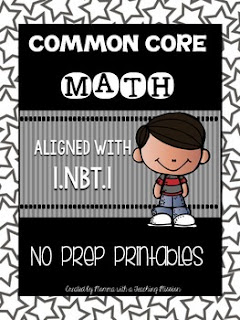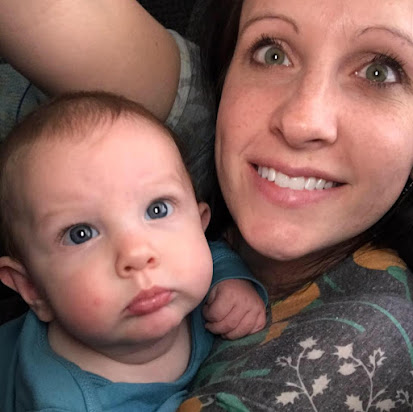Happy back to school season friends!! If you aren't already back in school, I'm sure you are going back sometime soon. I have been back in school for about 2 weeks now, and am tired as all get out!!
This is part 1 of a blog series to bring YOU some different games, resources and ideas to do with your primary (grades K-2) students.
Just a little background information on me--I am a STEM (which is math & science) teacher. I teach 1st and 2nd grade students. Students are flexibly grouped by their ability, which the opportunity to move up or down as the school year progresses if that is what the student needs. I teach 2 different groups of students; 1 group higher functioning 1st & 2nd graders (13 students- nine 2nd graders and 4 first graders) most of these students are on a first grade math level, which a sprinkle of a few students working on some 2nd grade standards. My 2nd group of students (10 students- 2 of which are 2nd graders, and 8 are first graders) are the lower of the two groups. These students are functioning on a kindergarten/pre-kindergarten math level. Both groups of students fall in the bottom 10% of students in grades 1 and 2. We call these classes "tier 3"--so I am a "primary tier 3 stem" teacher :)
So in case you have a few students that need something 'different' or maybe a whole class set, here are a few ideas of what I have been working on with them!
Counting Stations
One of the 1st standards I have begun to cover is 1.NBT.1 (common core). This standard states the student will be able to read, write, count, and represent any number from 1-120, starting at any given number.
So one of the first things we did to get acclimated to our classroom, and classroom materials, was to count different objects (with a partner). This was a random group of objects I put together, but the picture below can be used for counting stations with your students as the recording sheet.
I actually had a sub do this on a day I had to be absent (the 5th day of school). Then the following day, it led to a great conversation about putting objects into groups and counting that way (groups of 10s and counting by 10s). One could even change the quantities of the objects, laminate the recording sheet, and the the students work on the counting stations for an extended period of time (a week or so).
Exercising with Dice
So one of the independent rotations (stations) I added almost immediately was exercising with dice. I used
Whimsy Clips MEGA cute exercise clipart, and created some task cards on fun astrobrights paper. I added these fun, bright, foamy dice and
BAM the kids love it! I took a day (about 15 minutes) and as a class we went over each exercise. The students knew most of them from doing them in gym class.
Grocery shopping


I racked my brain to come up with a meaningful way for my kiddos to count. Many of them don't understand the value of being able to count. So why not add money?!?! I'm starting off with pennies and dollars, since both their value is 1, and hope to add nickels, dimes, quarters, as well as other dollar bills when the students are ready. I have 'differentiated' versions of grocery shopping for my 2 different classes of kiddos. The yellow cards (shown on the left) are for my students functioning on a 1st grade level. These task cards contain various items from the grocery store. The red task cards (shown on the right) are for my students functioning on a kindergarten level. These task cards contain fruits and vegetables. Within the rotation time, one students acts as the clerk, and the other as the buyer. The buyer says, "I would like to buy some bread" the clerk would then say, "you owe 1 dollar and 4 pennies". So the buyer would count out that much money, and any good clerk double checks the buyers coins and bills! The students love this role playing grocery shopping!
Racing to fill the chart
My kiddos desperately need to practice writing all their numbers from 1-120. Within my group of students functioning on a 1st grade level, I have them practice racing their partner to fill out the entire 120s chart. They each have a reference 120s chart, in case they need it. In my group of students functioning on a kindergarten level, I have them work with their partner to fill out either the 20s chart or 50s chart (depending on their ability). They also have a reference 120s chart to help them in case they become stuck.
120s Number Puzzles
I love these number puzzles! And I know I'm not the one who came up with this idea, but I'm not sure where I originally saw it! But, my students just struggled to put the numbers together, so I thought, why not add that reference 120s chart underneath to help them in case they get stuck! My students love these puzzles!
Fill 'er up!
This is a very simple game that you can have your students play. My students work in pairs, so I have 2 cups for them to work on filling up. They take turns rolling the dice, and then adding that many manipulatives (buttons in this picture) into their cup. The first person to fill up their cup is the winner. Of course, I switch out the manipulatives every couple days to keep it fresh for them.
Memory: Crossing the decade
This week I have played this memory game in small group with a few of my students. On the left side (to the students left, teachers right side) are the numbers ending in 9 (19, 49, up to 119), and on the right right are multiples of 10 (from 10-120). So as the students pull a card from left side, they read the number (ex. "This is 49") then they also say what they need to match it, (ex. "I need 50). So they pull from the left first, and then the right. If they get a match, they get to pick again, if they don't get a match, it's the next persons turn.
Before/After Number Bingo
This super simple game is one that my students have begged for this week! They have their game boards and chips, and I turn over a number card and ask, "what number is this" one of them answers, "seven", and then I ask, "What comes next? Cover it up!" The first student to get four in a row horizontally, vertically, or diagonally wins (a sticker---woohoo ;) )
Roll and count on
During small group, with about 4 students, I will tell them I am going to roll 2 dice to make a 2 digit number. I then tell them that they will tell me what comes next. So if I roll a 4 and a 9, I will say "ok 49, what comes next, and we will count on around the table (50, 51, 52, 53)". I will do this for multiple days, just for a couple minutes during our small group instruction. I am assessing to see if they can start from any number and count on.
Hopefully you've gotten some ideas to help your students number sense!
If you liked the ideas you read about in this post, you can find all them (plus some extras!) by clicking the image below!
If you are in need of some more formative assessments for your students for counting and the standard 1.NBT.1, feel free to check out these printables that are great for quick check ins, homework, or independent work by clicking the image below!
Make sure to follow me on
Facebook,
Instagram, and
Twitter to be notified of what is happening in my classroom to get some fun math ideas for your kiddos!






























































